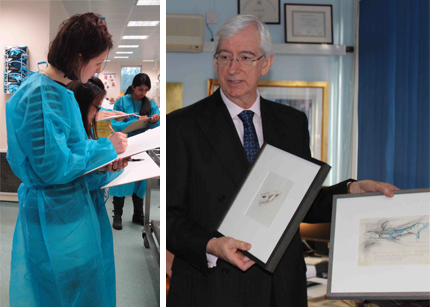Dr Philippa Lyon talks about a range of exciting collaborations between the Faculty of Arts and the Brighton and Sussex Medical School
21 Feb 2014

For a number of years now, I have been a member of research teams drawn from the Faculty of Arts and the Brighton and Sussex Medical School (BSMS) who collaborate to explore exactly these kinds of questions.
In the initial ‘Collaborative Drawing’ project we focused on the human body as a central theme. I conducted research with Patrick Letschka, Dr Tom Ainsworth of the Faculty of Arts, and Dr Inam Haq of the BSMS. A drawing course developed by Patrick and Tom was offered to a mixed group of Design and Craft BA(Hons) students and BSMS medical students. A collaborative approach encouraged interaction across the disciplines and students carried out a range of guided drawing exercises on subjects ranging from life models to the visual depiction of the sense of taste and the representation of anatomical specimens under laboratory conditions. Through these experiences of drawing and subsequent reflective discussion, students embarked on a process of questioning their perceptions and understanding of the human body and of the drawing process.
For the medical students in particular, the experience of drawing with design and craft students, of learning to ‘look’ in greater depth, was a significant journey. Some began the class ‘terrified’ of not being able to draw ‘accurately’, and for some, the opportunity to draw with design and craftstudents enabled them to question, explore and affirm their choice of discipline and career. By the end many had not only extended their understanding of what drawing might involve, but had made close connections between the process and experience of drawing and the problems of physical examination and diagnosis. The project has now been running for three years, resulting in a number of conference presentations and an article on the 2012 project findings published in open access journal BMC Medical Education. This work raised further questions that the researchers wanted to investigate, particularly: does drawing have a role in the work of craftspeople/designers and medics after leaving formal higher education?
In 2013, a project was carried out to explore the respective use, understanding and role of drawing within design/craft and surgical practice. This was jointly-funded by a University of Brighton Springboard development grant, BSMS, the faculty’s Centre for Research and Development and the School of Art, Design and Media.
Christopher Rose, previously a lecturer who led three-dimensional design and materials practice at the faculty and is senior critic in furniture design at Rhode Island School of Design in the USA, and Donald Sammut, a specialist hand surgeon who works in the UK and in Nepal, share a view that drawing is an important tool in their professional work. ‘The Conversational Drawing’ project brought them together, not only to draw, but also to discuss the different conceptions of drawing within their respective disciplines and professional roles. The resulting video, with conversation ranging from the philosophical to the practical, can be viewed below as a free educational resource.
Drawing Conversation from Philippa Lyon on Vimeo.
A further strand of medical drawing research has been identified by Martha Turland, lecturer in Historical and Critical Studies, with whom I collaborate. This focuses firmly on the phenomenon of medics and surgeons who draw in the clinical consultation. Martha Turland observed that health professionals often draw for their patients, or each other, as part of clinical communication. But why do doctors, nurses and other health professionals continue to do this, given the body of photographic and illustrative images now available for such purposes? What underlies the marks they make and what is the impact on the patient? Are these drawings effective as explanatory devices, and if so, is it because they are produced sequentially and ‘live’ in the moment of professional/patient interaction, or because they relate to the patient’s body rather than a generalised idea of ‘the body’? Is there a system or ‘grammar’ to the marks used in these drawings?
Following three conference presentations in 2013, and a range of discussions with potential collaborators, we have now refined these and many other questions and have designed a pilot study for which we are currently seeking funding. The project has attracted interest from both BSMS and leading Cardiothoracic surgeon, Francis Wells, who is based at Papworth Hospital, Cambridge.
Our most recent project involves the planning of a graphic novel, which will explore the patient and surgeon’s journey from diagnosis to post-operative care, Martha is leading this project with Francis, and two established graphic medicine novelists, Nicola Streeten and Ian Williams, who will be working with graphic design and illustration students at Brighton.
A further development has been a drawing and health university studentship awarded to student Curie Scott in 2012, who is currently exploring the use of drawing in an intergenerational group of health professional students and older people, to explore their perceptions of ageing.
The medical drawing/drawing and health research, together with a range of other projects and interests is discussed at the Drawing Research Interest Group which is open to all those with a research interest in these areas.
A small work-in-progress exhibition featuring some work by members of the group and Francis Wells will be shown in the forthcoming faculty exhibition, Mobility of the Line/Utility of the Line, which opens on 7 March at the faculty’s Grand Parade campus.
Read more about this research.
